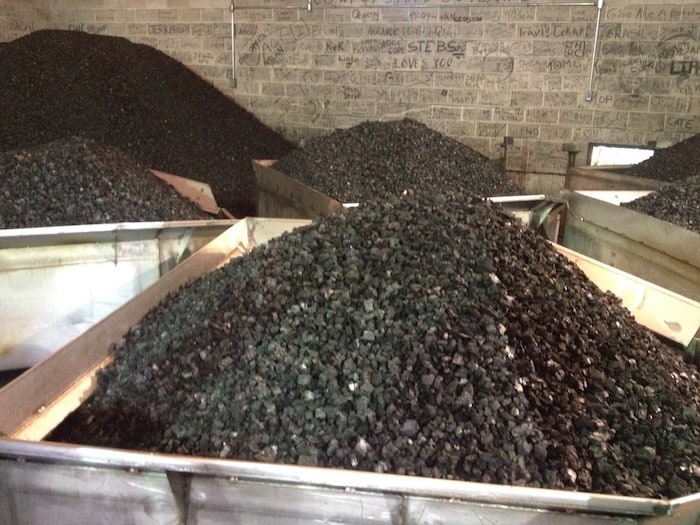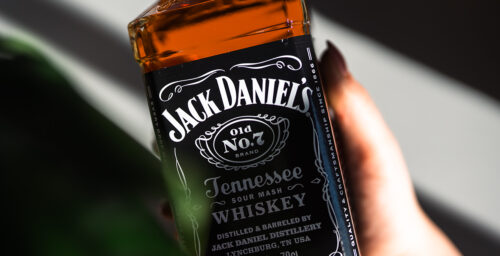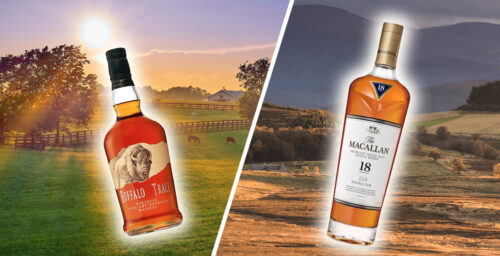Editor’s Note: This column is republished with the permission of its author. Also, Chris Middleton, the former Global Brand Director for Jack Daniel’s, helped with it.
On New Years Day, we answered once and for all the question “Is Jack Daniel’s Bourbon?” There is more to the story, however, going back almost 200 years.
At the heart of the controversy is the ‘Lincoln County Process,’ in which new make distillate is passed through thick vats of sugar maple charcoal. Although the process is very old, the term ‘Lincoln County Process’ is of recent coinage, the 1950s, shortly before the Motlow family sold the company to Brown-Forman. Up until then, most people just called the practice ‘leaching’ or ‘charcoal leaching.’
In the 19th century, it was common among Tennessee distillers to run their new make through sugar maple charcoal. For roughly the first half of that century, most whiskey was sold unaged, but improving the flavor of new make continued to seem like a good idea even after aging became the rule.
By the 1950s, Jack Daniel’s was the only distillery in the United States still leaching. They wanted to talk about it in marketing because they thought it made their whiskey unique, but ‘leaching’ didn’t sound very appetizing. The process needed a new name.

‘Lincoln County Process’ was derived from the term ‘Lincoln County Whiskey.’ From the early 1830s, Tennessee’s Lincoln County was renowned as America’s most productive corn cultivation district.
Lincoln County was once much larger than it is now and included the Jack Daniel’s Distillery in Lynchburg. Moore County, where Jack Daniel’s is today, was established in 1871 from parts of Lincoln and three other counties.
Lincoln County’s reputation for fine corn passed on to its whiskeys. Like Monongahela rye, the use of Lincoln County corn was a selling point for middle Tennessee whiskeys. Starting in 1866, distilleries and brokers advertised in newspapers their ‘Lincoln County whiskey,’ specifically to differentiate it from the Robertson County product, Tennessee’s other popular whiskey style, as well as from Kentucky bourbon and other regional whiskeys.
During the early 1900s, the Jack Daniel’s label stated ‘Jack Daniel’s Pure Lincoln County Corn Whiskey.’ It was never called bourbon. That would have been unthinkable.
That is how the Lincoln County Process got its name, but what about the process itself? Does it disqualify Jack Daniel’s from being called bourbon?
People who say it does cite section 5.23 (b), which reads in part: “Extractions. The removal from any distilled spirits of any constituents to such an extent that the product does not possess the taste, aroma, and characteristics generally attributed to that class or type of distilled spirits alters the class and type thereof, and the product shall be appropriately redesignated. In addition, in the case of
straight whisky the removal of more than 15 percent of the fixed acids, or volatile acids, or esters, or soluble solids, or higher alcohols, or more than 25 percent of the soluble color, shall be deemed to alter the class or type thereof.”
The only problem is, 5.23 (b) doesn’t apply since charcoal leaching occurs before the distillate has been classified. Until it touches an ‘oak container,’ it is not whiskey, let alone bourbon. You can’t change the classification of something unclassified. Section 5.23 very clearly applies only to classified products. If a post-classification process changes the liquid’s characteristics, as described in the rule, then reclassification is necessary. Since whiskey must be aged, section 5.23 clearly applies to aged liquid only, not to new make.
Most distillers agree that pre-barrel charcoal leaching functions as a kind of jump-start to the aging process, removing or modifying some of the undesirable congeners that will eventually be removed or modified by the oak barrel’s charred interior surface. Jack Daniel’s may age a little faster as a result, but that’s it. The bourbon gods are not offended.
This got confused when the type of charcoal leaching practiced in Tennessee became less common, because charcoal leaching is also widely employed by rectifiers. In 1868, the Federal Government passed a number of taxation acts, based on the 1864 Special Tax Act and the amended Trades Special Tax of 1866. One of these included a tax on rectifiers.
Rectifiers were defined as: “every person who rectifies, purifies, or refines distilled spirits or wines, by any of process other than the original and continuous from mash, wort or wash, through continuous closed vessels and pipes, until the manufacture thereof is complete, and every wholesaler or retail liquor dealer who has in his possession any still or leach tub; or such keep and apparatus for the purposes of refining any manner distilled spirits (etc.)” ‘Leach tub’ refers to the process of rectifying a spirit by filtering it through charcoal.
The Rectifiers Special Tax was based on the volume of spirit a rectifier processed. The average tax was $4 a barrel. A spirit barrel was defined as 40 gallons at proof strength (i.e., 50% alcohol by volume).
The Tennessee distillers lobbied the IRS and gained an exception to the tax for their ‘redistillation, leaching and vaporising’ methods, which they used to make straight whiskey, not neutral or nearly-neutral spirit as was the business of rectifiers. The Tennessee distillers insisted they were not rectifiers but primary distillers and, as such, they were already paying the Federal Excise Tax on their output. Levying an additional rectification tax on the same liquid would be unfair. In agreeing and granting the exception, the IRS effectively recognized Tennessee whiskey as a distinctive version of straight whiskey, way back in the 19th century.
The new liquor laws passed right after Prohibition did not include a contingency for Tennessee’s charcoal leaching method. This may be because no one in Tennessee was distilling at the time due to Tennessee’s state Prohibition laws remaining in effect after 1933. When distillation finally became legal again in 1937, only Jack Daniel’s came back in a meaningful way. They resumed making ‘Lincoln County Whiskey’ the way they always had, using Lincoln County corn and charcoal leaching of new make before barreling. Because so few distilleries came back after Prohibition, a once common practice was nearly extinct. Only one distillery, Jack Daniel’s, was still doing it.
When the time came to start selling their whiskey, Jack Daniel’s sought an exception similar to the one granted in 1868. They wanted to be acknowledged as distillers of a straight whiskey product, but one that was distinct from bourbon or rye. They wanted the feds to create a Tennessee whiskey classification but settled for ‘whiskey.’ Then they put ‘Tennessee’ in front of it as a truthful statement of product origin, which was permitted under the new rules.
That is how the designation ‘Tennessee Whiskey’ was born.
From reading Deputy Commissioner Berkshire’s letter, I think what went down in 1941 was on the order of an accommodation, a simple solution to a unique problem. Because only Jack Daniel’s had this issue, the exception would affect only them, so why formalize it? (George Dickel was still 20 years in the future.)
The fact that Jack Daniel’s was accepting a lower classification and rejecting a higher one also suggested a one-off proposition, an anachronism unlikely to recur. Writing a letter is much more efficient, administratively, than undertaking the rule change process. The fact that this occurred almost 80 years ago and hasn’t caused any problems (other than confusing a few obsessives) means it was probably a good administrative decision.
Chris Middleton, the former Global Brand Director for Jack Daniel’s, helped a lot with this post.









